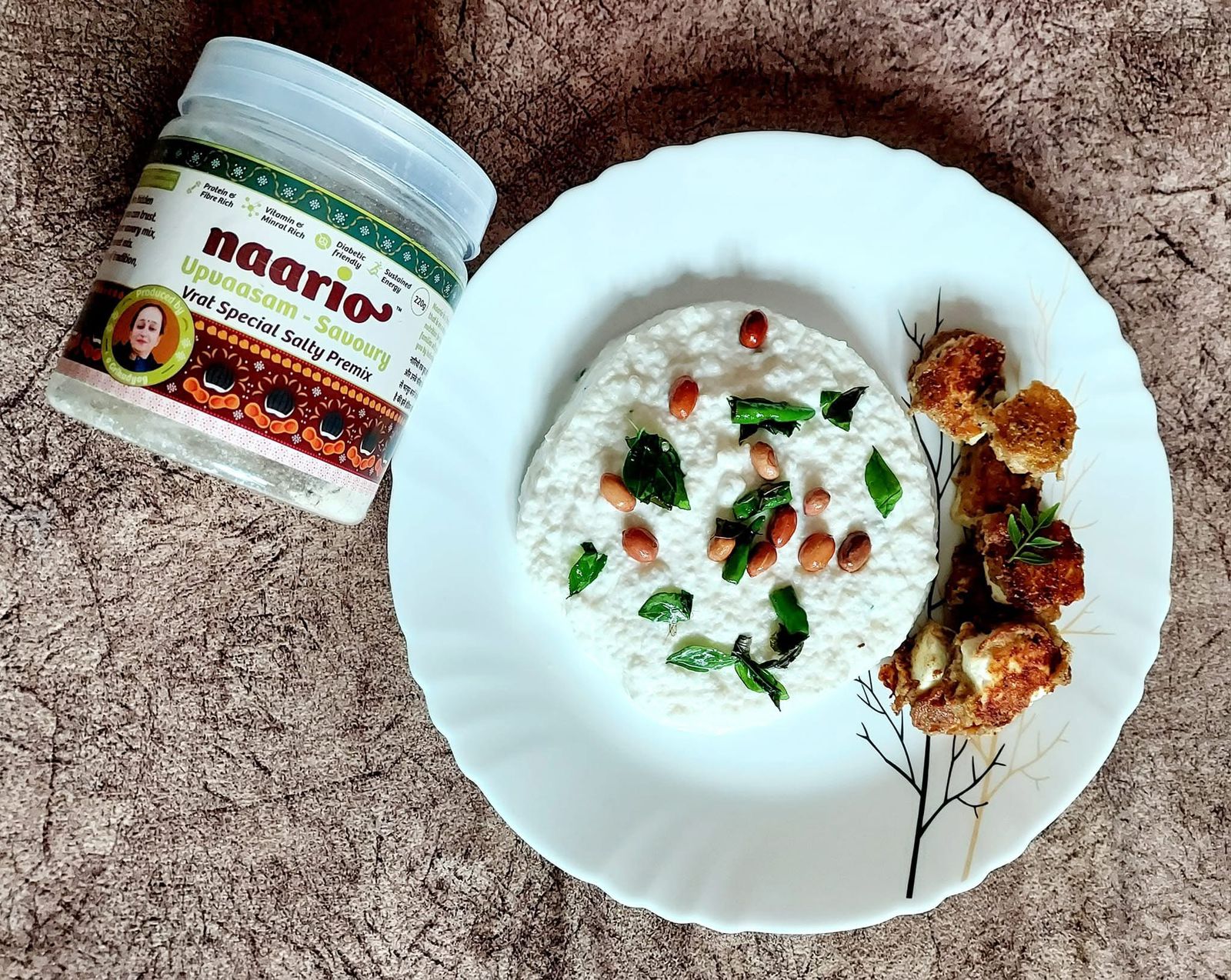

Sacred Foods of Navratri: Stories & Meaning Behind Sattvik Eating
Introduction
Navratri is one of India’s most cherished festivals — nine nights of prayer, music, dance, and devotion to the Divine Mother. But Navratri is not just about rituals and celebrations; it is also about cleansing and balance. That’s why millions of devotees switch to a sattvik diet during these nine days.
But why exactly are foods like sabudana, kuttu, singhara, lauki, and sweet potato allowed, while staples like wheat, rice, and onion are avoided? This is not random tradition. Each vrat-friendly food has a deep cultural meaning, spiritual symbolism, and health benefit.
Let’s uncover the sacred connection between Navratri fasting foods, ancient wisdom, and modern wellness.
What Does “Sattvik Eating” Mean?
The term sattvik comes from the Sanskrit word sattva, which means purity, harmony, and balance. According to Ayurveda:
Sattvik foods → pure, light, and calming for body and mind.
Rajasic foods → stimulating (like onion, garlic, heavy grains).
Tamasic foods → dulling or heavy (like meat, alcohol, processed food).
👉 During Navratri, when the goal is to turn inward, purify the body, and focus on devotion, sattvik foods are chosen because they:
Calm the mind for prayers and meditation.
Provide clean energy without heaviness.
Aid in detoxification and digestion.
Encourage discipline and mindfulness.
In short: Sattvik eating is about nourishing the soul, not just the body.
1. Sabudana (Tapioca Pearls): Patience & Sustained Energy
Cultural & Spiritual Meaning
Sabudana requires soaking and careful cooking — teaching patience, discipline, and devotion. Traditionally, it is seen as a food that sustains devotees during long fasting hours without causing heaviness.
🌱 Health Benefits
Rich in carbohydrates → steady energy release.
Easy to digest → prevents bloating or heaviness.
Paired with peanuts → balances carbs with protein.
💡 Modern Tip: Try Sabudana Khichdi cooked in ghee with peanuts and lemon juice for a nourishing lunch.
2. Kuttu (Buckwheat): Strength & Grounding
Cultural & Spiritual Meaning
Although called flour, kuttu is actually a seed, not a grain, making it sattvik. Its earthy taste and heaviness symbolize strength, stability, and being grounded in devotion.
🌱 Health Benefits
Gluten-free and protein-rich.
Improves metabolism and heart health.
Great source of minerals like magnesium.
💡 Modern Tip: Make kuttu cheela or pancakes for a healthy lunchbox option.
3. Lauki (Bottle Gourd): Purity & Cooling
Cultural & Spiritual Meaning
Lauki is humble, simple, and sattvik — a vegetable that represents purity, balance, and humility. It’s believed to cool the body during fasting and align with calm devotion.
🌱 Health Benefits
90% water → keeps the body hydrated.
Supports digestion and prevents acidity.
Light, making it perfect for late-night meals after puja.
💡 Modern Tip: Blend lauki with mint and lemon into a refreshing detox drink.
4. Singhara (Water Chestnut): Fertility & Vitality
Cultural & Spiritual Meaning
Singhara flour is often used for pooris or rotis. It is a symbol of vitality, fertility, and prosperity, making it auspicious during fasting.
🌱 Health Benefits
Rich in potassium, iron, and calcium.
Boosts immunity and stamina.
Keeps blood sugar steady.
💡 Modern Tip: Make singhara pancakes with honey for a quick breakfast.
5. Sweet Potato: Devotion & Sweetness of Faith
Cultural & Spiritual Meaning
Sweet potato represents sweetness in devotion and humility in offerings. Its natural sweetness is seen as God’s prasad, reminding devotees that fasting is not about deprivation but about divine joy.
🌱 Health Benefits
Packed with Vitamin A → glowing skin.
Fiber-rich → prevents energy crashes.
Balances hormones and immunity.
💡 Modern Tip: Air-fry sweet potato wedges instead of frying for a guilt-free snack.
6. Dairy: Divine Nourishment
Cultural & Spiritual Meaning
Milk, yogurt, paneer, and ghee are central to sattvik diets. The cow is sacred in Hinduism, and dairy symbolizes prosperity, purity, and divine nourishment.
🌱 Health Benefits
Yogurt = probiotics → gut health.
Milk = protein + calcium.
Ghee = healthy fats for glowing skin and stamina.
💡 Modern Tip: Replace fried sweets with fruit + yogurt bowls sweetened with jaggery.
7. Nuts & Dry Fruits: Strength & Resilience
Cultural & Spiritual Meaning
Dry fruits are considered gifts of nature — small yet powerful. They symbolize strength, resilience, and abundance and are often offered as prasad.
🌱 Health Benefits
Almonds & walnuts → brain health.
Raisins → iron for energy.
Cashews → good fats for stamina.
💡 Modern Tip: Carry a dry-fruit trail mix for office snacking.
8. Why Certain Foods Are Avoided
During Navratri, devotees avoid:
Onion & garlic → believed to increase tamas (inertia).
Wheat & rice → considered rajasic (stimulating, heavy).
Meat, alcohol, processed food → lower vibrations, not sattvik.
👉 The purpose is to create lightness in body and clarity in mind, supporting devotion.
Stories Behind Navratri Foods
Sabudana: Said to sustain sages during meditation in forests.
Kuttu: Consumed by warriors before battles for strength.
Lauki: Offered in temples as a sattvik prasad.
Sweet Potato: Associated with Goddess Shakambhari, who nourishes with plant foods.
These stories remind us that food is not just fuel but a sacred offering.
🗓️ Sample Navratri Sattvik Thali
Morning: Lemon water + soaked almonds.
Breakfast: Millet Muesli with curd + fruits.
Lunch: Kuttu cheela + lauki curry + cucumber salad.
Snack: Roasted makhana or Bhakhri with mint chutney.
Dinner: Sweet potato tikki + singhara roti + yogurt.
Conclusion
Navratri fasting is not simply about avoiding food — it’s about choosing foods that are pure, sacred, and aligned with devotion. Each sattvik ingredient — from sabudana to sweet potato — carries a story of culture, spirituality, and wellness.
This Navratri, when you sit down to your vrat thali, remember: you are not just eating, you are connecting with centuries of wisdom that nourishes body, mind, and soul.
✨ Let your plate be as sacred as your prayers.
🛒 Call to Action
🌾 Make sattvik eating simple with Naario:
Millet Muesli → sattvik breakfast in 5 minutes.
Bhakhri → ready-to-eat, sattvik snack for office or garba nights.
